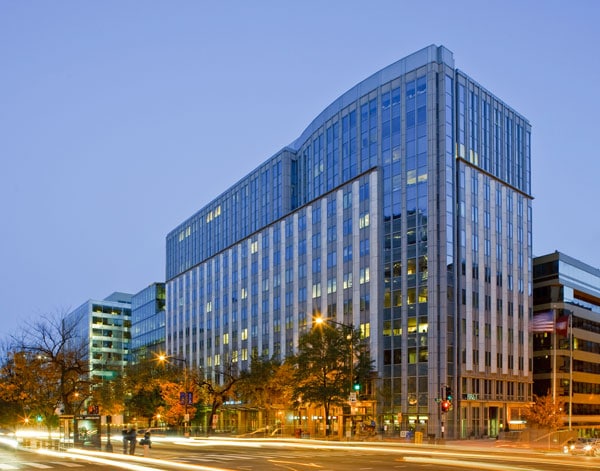At 1909 K Street in Washington, D.C.’s bustling Golden Triangle district stands a gleaming example of what dedicated and mindful long-term management can bring to the sustainability movement in corporate real estate. The 33-year old Millennium Building, owned and operated by D.C.-based The Tower Companies, is 235,000 square feet of class A commercial office space. The property first earned LEED Certification in 2009 and later re-certified to achieve LEED Gold under Existing Buildings: Operations and Maintenance (EBOM). In addition, the team has earned ENERGY STAR certification each year since 2010 and is also BOMA 360 certified.
The Tower Companies’ focus on sustainability at The Millennium Building and across its portfolio goes back much further than their first green building certification. Since 2005, Tower has made a commitment to purchase renewable energy and carbon credits to offset 100% of their energy usage across the entire portfolio. In 1997, The Millennium Building completed a major renovation and added four floors without increasing its energy footprint. In 2014, the building team flipped the switch on a 30 kW roof-mounted solar array, the first PV installation on a D.C.-area building of its type. The 40,000 kWh produced annually are enough to power three elevators. “In everything we do, we ask the question, is it sustainable?” says Debbie Webb, vice president of property management at The Tower Companies. “How do we connect the building and the clients to the environment? How do we connect all three in a unified way?”

PHOTO: RON BLUNT
Webb says that she finds the answers to those questions arise through continual communication between the building’s tenants, management staff, and engineers. Real-time energy monitoring has provided a basis for many small improvements that have added up to big savings. After establishing a baseline in 2010, energy use decreased 27% by 2014, well ahead of the established goal of 20% by 2020. Improvements in water use efficiency were even more dramatic, dropping by a whopping 50% by 2014 over the 2010 baseline. They’ve also diverted waste from landfills by about 50% in recent years.
The Tower building staff has also organized a “Green Team” in the building, which consists of representatives from each tenant suite that meet for brainstorming sessions that often produce out-of-the-box ideas that lead to practical improvements and sustainability best practices. “We talk about building sustainability metrics and get feedback from tenants to understand how we can be a resource to help their office with sustainability goals,” Webb says.
There is also a lot of what Webb calls “extras”—little things that The Tower Companies chooses to do to encourage a healthy culture in the workplace for their “clients,” the companies preferred way of referring to their tenants. Most of the “extras” don’t come with a financial incentive for the company, but many of them create positive impacts on the environment, as well as the community and are considered building amenities for their clients. For example, in addition to the Millennium Building’s electric car charging stations, they’ve built a top-notch bike room with lockers, tools, interactive maps of the city’s bike routes, and, “not of minor importance,” adds Webb: air conditioning. “That way, at the start and end of your ride, you’re in a good place.”

The building includes a top-notch bike room with showers, lockers, tools, and maps of the city’s bike routes. The room is also equipped with air conditioning, which in some cases may go unnoticed, but allows for a good start and end to a commute. PHOTO: JIM LEWIS
On the roof, employees are welcome to harvest from the organic herb garden, should they need a bit of rosemary or oregano for their dinner plans. The building team has also partnered with a local company to provide another convenient option to clients—weekly farm-share bags delivered right to their office door. It’s those small things that often signify a true leader in the eyes of TOBY judges, who seem to appreciate The Tower Companies’ approach, handing them a regional Earth award in 2015. “As a small company with almost 100 people, that was a huge honor for us,” Webb says. “We’ve been building up to this for a long time and the team earned it.”
By the Numbers:
27% After establishing a baseline in 2010, energy use nosedived by 27% in 2014, well ahead of the established 20% goal by 2020.
50% The whopping drop in water use efficiency over the 2010 baseline
30kW The solar array size that is located on the roof of the building. It produces 40,000 kWh annually, which is equivalent to running 3 elevators for one year.
50% The amount the building has managed to ratchet down their waste stream in recent years
Download a PDF of this story here.

